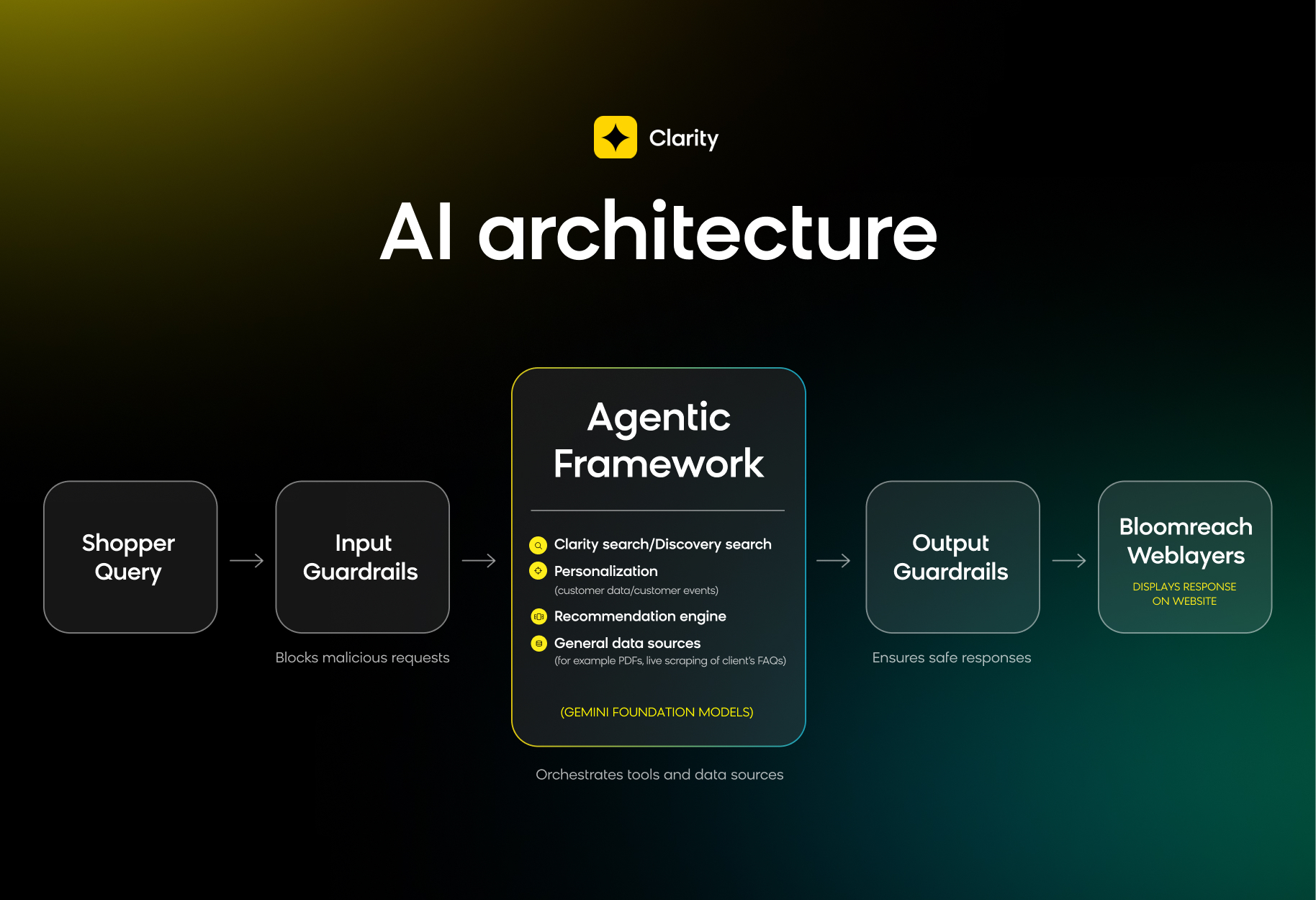How Clarity uses AI
This guide covers how Bloomreach Clarity uses AI while maintaining user trust and transparency.
Core AI application
Clarity uses Bloomreach's proprietary e-commerce-optimized agentic framework to power intelligent shopping conversations. Through Bloomreach’s partnership with Google, the framework runs on the latest Gemini foundation models.
Bloomreach Weblayers embed the Clarity experience on a website and display relevant personalized content at the right time and location for each shopper.
Query processing
Clarity uses a powerful agentic architecture to handle user queries. It connects with Bloomreach's extensive suite of tools for tasks ranging from product catalog searches (via either Discovery Search or Clarity Search) to personalized responses based on past shopper behavior.
Clarity has an optional capability of using LLMs to augment product feeds by improving descriptions and generating new product attributes.

Clarity's AI architecture
Secure data handling
Data architecture
Clarity ingests, processes, and secures three types of data:
-
Product data: Clarity ingests your product data either via Clarity Search or Discovery Search. This allows Clarity to truly understand your product feed and find matching products not just through exact matches, but by grasping their deep semantic meaning.
-
Customer data: Clarity uses Bloomreach's data engine to store and access information about shoppers. For existing Bloomreach Engagement customers, all historic data stored in the data engine is available for use within Clarity.
-
General knowledge data: Clarity stores general knowledge data, which includes textual data. For instance, PDFs, raw text, or URLs.
Check this article on data captured and stored by Clarity.
Security and privacy measures
To ensure privacy and data security, Clarity:
- Runs a private instance for all calls to Gemini LLM models.
- Never shares customer data with third parties to train the underlying models.
Robust AI risk management system
Guardrails module
Clarity mitigates risks via runtime guardrails that limit any potentially malicious requests:
- Run input guardrails to block malicious user behaviour. Clarity maintains the context and responds to malicious user requests with "Sorry, I can't help you with that".
- Run response guardrails to ensure Clarity’s responses are safe, block potentially unsafe responses, and match the guidelines defined within your tone of voice.
Safety testing
Bloomreach performs regular and rigorous testing to ensure safe Clarity responses. The testing ensures that Clarity follows proper business processes, protects confidential business information, prevents unauthorized access, and keeps conversations appropriate and relevant.
Clarity's guardrails, along with its agentic framework, prevent it from generating "unsafe" responses. This includes:
- Answering questions irrelevant to the business context (for example, responding to "Who is the US president?").
- Discussing topics prohibited by the Bloomreach customer (for example, politics, war).
- Using terminology prohibited by the Bloomreach customer (for example, the term "hand-made").
Handling of AI bias
Clarity, by design, minimizes AI bias by referencing product data and limiting the use of raw LLM knowledge.
Product feed reference
Clarity uses your product feed to answer product-related queries. Unless the product feed is outdated or incorrect, Clarity consistently presents accurate and relevant information sourced directly from the product feed, reducing risks related to biased responses.
Selective use of LLM knowledge
Clarity leverages your product data as the primary source to answer product-specific questions. General LLM knowledge serves as supplementary reasoning logic only when relevant. This reduces misinformation risks.
For example, if a shopper asks, “Will this mattress fit my bed with dimensions 76x80 inches?”, Clarity verifies using the product feed and comparative reasoning to check whether the product matches the given dimensions.
How Clarity limits use of raw LLM knowledge
Clarity uses the input and output guardrails to filter relevant queries and check responses based on the guidelines you set.
Clarity’s agentic framework uses the LLM as an intelligent orchestrator that selects appropriate tools and actions. The LLM's role is to:
- Identify which Bloomreach tools are relevant for a query.
- Determine the sequence of actions, such as performing a search or checking an FAQ article using RAG (Retrieval-Augmented Generation).
- Present results in a conversational format.
This architecture ensures that the LLM coordinates tools rather than relying on raw knowledge. However, as with all LLM-powered tools, errors can occur.
External sources of bias
Clarity may inherit bias from external sources it can't control:
- Third-party AI models, including LLM and embeddings from Google.
- Merchant-provided data, including product catalogs and Discovery merchandising rules.
The platform itself doesn't introduce additional bias through its agentic orchestration logic.
AI use transparency
The Clarity chat widget displays a customizable AI disclaimer at the bottom to ensure transparency regarding AI use. The default disclaimer is “Responses use AI and may contain errors.”
Disclaimer customization
The Bloomreach team can edit the default AI disclaimer to match your legal constraints. Contact your Bloomreach representative to modify the disclaimer.
Disclaimer truncation
To ensure the disclaimer appears on a single line, longer disclaimers are truncated using a fixed character cutoff, rather than a dynamic cutoff based on the screen size. Any text exceeding the cutoff is hidden behind a tooltip.
Cutoff lengths
- Mobile: 50 characters
- Desktop: 65 characters
AI compliance at Bloomreach
To learn more about the complaint development and deployment of AI at Bloomreach, contact:
Data protection officer: [email protected]
At Bloomreach, we're deeply committed to building AI the right way. Visit this article on Bloomreach’s AI development principles.
Updated 29 days ago
